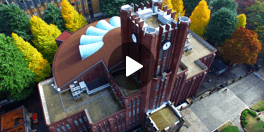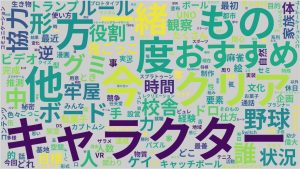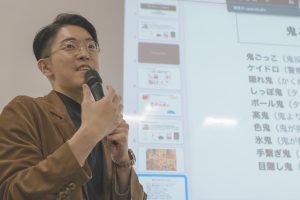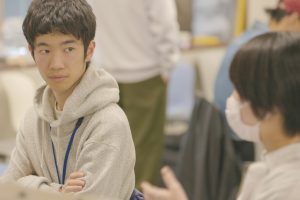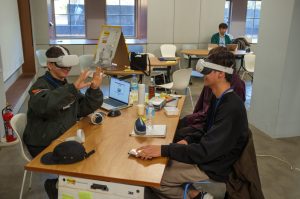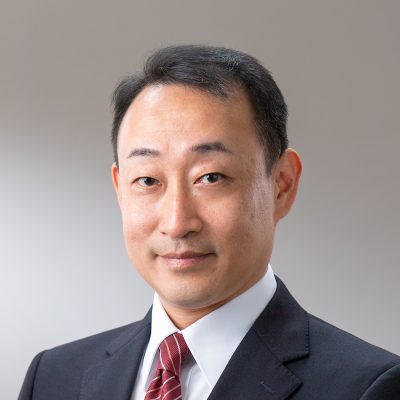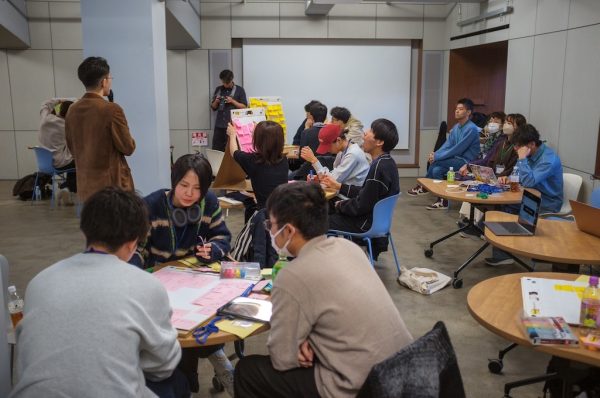
March 21, 2024
学生向けハッカソン「あそびの未来ファクトリー2024」Future Factory of ASOBI 2024: Students' Hackathon
2024年2月13日(火)から2月28日(水)にかけての2週間、第6回目となる「あそびの未来ファクトリー2024」が開催されました。このイベントは学生向けのハッカソンでこれまで東大生向けに実施していましたが、今回からは東大外からも参加者を募ることとなり多様な参加者構成となりました。昨年より対面実施ができるようになり情報学環オープンスタジオで行いました。
ハッカソンのテーマとして、「”未来のあそび”をチームでつくりだす」ことが与えられ、「あそび」とはそもそもどういったものなのか歴史を辿り議論の土台を作り、各チーム様々な切り口であそびについて考えを深め、中間発表、最終審査とチーム対抗でアイディアを競うこととなります。
初日は参加者、審査員、アドバイザー、スタッフなど全員が顔を合わせるキックオフとなります。自己紹介やチーム作り、倉本大資特任研究員によるあそびの類型のレクチャーや、安斎勇樹特任助教によるあそびのつくり方に関するワークショップが実施されました。チーム作りは、参加者自身にあらかじめ作成してもらった自己紹介スライドを看板のように持ち、参加者同士動き回り自己紹介や関心事など話に花を咲かせ、続々とチームが出来上がっていきました。
2日目からは「技術サポートday」として、アドバイザーとして招かれたさまざまな分野のクリエイターより、チーム毎に助言を得たり、アイディアを深める機会となりました。また、基本対面を前提に進めていましたが、各チームとも上手くオンラインツールを使用し、チームメンバーの都合等に合わせチームでの活動を続けていたのは印象的でした。
中間発表では各チームが進行中のアイディアをスライドを用いて発表し、審査員やアドバイザーからフィードバックをもらうように進めました。発表スライドを作る際も、「遊びたくなるように」「遊ぶイメージが伝わるように」といった工夫が見られ、進み具合により試行錯誤途中のプロトタイプの披露もありました。
そしてまた数日の技術サポートdayを挟み最終審査に向け各チーム制作を続けました。このハッカソンの最終成果物として、「考えた”未来のあそび”を5分以内の動画にする」ことがあります。遊んでいる様子を動画に撮るためには、実際に遊べる状態のプロトタイプが必要となります。ただ思いついたままのアイディアだけでは評価されません。各チーム実装を進めていきますが、ある程度形になり実際に遊んでみると意外な面白さが分かったり、微妙なところなど問題も出てきます。そうした試行錯誤をチームメンバー、アドバイザー、中にはチーム相互に行うなど、ブラッシュアップしていきました。
最終審査では、作成した動画を見せるのに加え各チームデモをしたり、審査員に実際に遊んでもらったりして作品をアピールします。動画の時点でどよめきの起きるもの、遊んでいる様子を見て参加者の気を惹きつけるものなど様々でチームごとに特色がありました。特にあそびの捉え方がチームごと様々な方向性があり、特に味覚や嗅覚にまで及ぶ様子は見ていてまだ広がる可能性を感じました。
その後審査を経て最優秀賞、実装賞、プレゼン賞の各賞を選出し表彰しました。結果はあそびの未来ファクトリーのサイトに掲載しています。審査を行っている時間は参加者の交流の時間とし、各チームのつくったあそびを互いに試遊したり2週間完走した者同士の苦労などを分かち合っていました。
私も参加者と話してみると、「想像していた2週間より短くあっという間だった」「初対面の人と組むチームだがとてもスムーズに進んだ」「このチームでまた何かやりたい」といった声を聞くことができ、一人一人が学んだことは異なっても、学習環境としてポジティブに受け止められている様子がわかりました。
今回、様々な所属の参加者を集め実施することになりましたが、期間中や終了後もお互いの研究室訪問などの形で交流のある様子が伺えます。ここでのつながりや経験が今後の活動に活かされることを願っています。
記事:倉本大資(特任研究員)
The 6th “Future Factory of ASOBI (play) 2024” was held for two weeks from February 13, 2024 (Tue) to February 28, 2024 (Wed). This event is a hackathon for students and has previously been held for University of Tokyo students, but henceforth participants will also be recruited from outside the University of Tokyo, resulting in a diverse participant composition. Since last year, we have been able to hold face-to-face meetings at the Open Studio .
The theme of the hackathon was “Creating “future play” as a team”. Having traced the history of “play” to create a basis for discussion, each team looked at play from a variety of perspectives, deepening their ideas and placing them against the ideas of other teams through interim presentations, final screening, and team competition.
The first day, February 13th, was the kick-off where all participants, judges, advisors, staff, and other personnel met at the venue. There were self-introductions, team building, a lecture about the classification of play by Project Researcher Daisuke Kuramoto, and a workshop on how to create play by Project Assistant Professor Yuki Anzai.
To build teams, participants used self-introduction slides they had created in advance like billboards. The participants walked around, introducing themselves to other participants and talking about their interests, leading to the formation of one team after another.
Starting with the second day, there were “technical support days,” where each team was able to deepen their ideas after receiving advice from creators from various fields invited as advisors. Additionally, although the event proceeded on the basic premise of face-to-face interaction, it was impressive that each team skillfully used online tools and found ways to continue their activities at the convenience of the members.
At the interim presentation session, each team presented their ideas using slides, and received feedback from the judges and advisors. When creating their presentation slides, they tried to “make them want to play” and “convey the image of playing”. Depending on the state of progress, they even showed off prototypes that were still in the process of trial and error.
Then, with a few technical support days in between, each team continued production in preparation for the final judging. The final aim of the hackathon was to create a 5-minute video of the “future play” that the participants had come up with. In order to record a video of the game being played, a prototype that can actually be played was required. Ideas remaining only the level of initial conception received no evaluation.
Each team continued to implement their ideas, but once they had taken shape to a certain extent and could actually be played, unexpected aspects came to light, as well as subtle issues and other problems. Skills were honed through trial and error and interaction among team members, with advisors, and even between teams.
During the final judging, in addition to showing the videos they had created, each team promoted their work through demonstrations and having the judges and advisors actually play the game. Each team displayed its own character: some caused a stir when showing the video, while others caught the attention of the participants as they watched the game being played. In particular, each team had a different approach to how they perceived play, and I saw how this extended to the senses of taste and smell, where I felt there was still great potential for expansion.
After a review, the receivers of the Grand Prize, Implementation Award, and Presentation Award were selected and awarded. The results are posted on the Future Factory of ASOBI (play) website. The judging period was used as a time for participants to interact, trying out the games each team had created, and sharing the challenges faced by those who had completed in the two-week hackathon.
When I talked to the participants, I heard things like, “The two weeks went by so quickly and was shorter than I expected,” and “Even though I was working with someone I had never met before, things went very smoothly,” and “I want to do something with this team again.” Even though each participant came away with something different, the learning environment was universally perceived as positive.
Having decided to open the event to participants from various institutions, we can see that they are continuing to interact with each other in the form of visits to each other’s laboratories during and after the event. I hope that the connections and experiences they have made here will be utilized in their future activities.
Text: Daisuke Kuramoto (Project Researcher)
English proofreading: David Buist (Project Senior Specialist)
主担当教員Associated Faculty Members
教授
苗村 健
- 先端表現情報学コース
- 情報学環教育部
Professor
NAEMURA, Takeshi
- Emerging design and informatics course
- Undergraduate research student program

